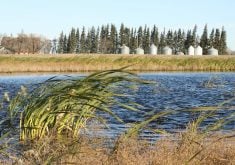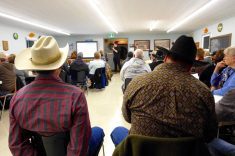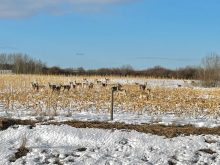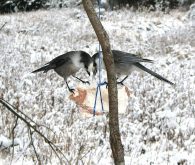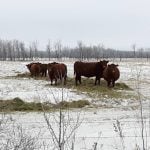Manitoba Beef Producers are looking to other jurisdictions for solutions to predation.
It’s the second year in a row that MBP’s District 10 meeting in the Arborg area, held Oct. 19, featured a resolution to overhaul Manitoba’s Problem Predator Removal Program.
The Interlake is a hotbed for predation. Northern reaches of the district have more wolf predation than areas further south.
Read Also

Beekeepers want financial protection against tropi mite
What happens to beekeepers if the deadly tropi mite reaches Canada? Discover why farmers want robust compensation to protect pollination.
Why it matters: Predation continues to be a serious issue for livestock producers, despite programs meant to sponsor prevention efforts or remove problematic coyotes, wolves or foxes.
The provincial program is administered through the Manitoba Trappers Association. Producers can invite trappers to their farms to deal with predators that have attacked livestock or pose a human safety risk.
The farmer must provide proof of predation, usually a carcass, and apply for the Wildlife Damage Compensation Program offered through Manitoba Agricultural Services Corp., which compensates farmers for predation losses.
At that point, the farmer is eligible for support through the predation program. They can then contact the trappers association with their MASC claim number and, in theory, a trapper would be assigned to their case.
That doesn’t always happen. Beef producers say there’s not enough incentive for trappers to sign on to the program.
Registered trappers are paid an hourly rate and mileage to and from the farm’s location, but the funding allocated to the program is fixed and, according to the Manitoba Trappers Association website, trappers have a limited number of hours to deal with a specific request. And since the fur market has dwindled, pelts are not as valuable.
During the meeting Oct. 19, one farmer said they were told they were too far away when they called the trapping association to request a visit.
“What it boils down to is that the overall program just doesn’t have the administrative coverage,” said MBP general manager Carson Callum. “So, the trappers that have to expend fuel to haul all their equipment out are not seeing a return. The incentive for them is not there.”
In an interview after the meeting, Callum said the resolution was no surprise.
“We’ve seen a downturn in the number of skilled trappers able to remove those problem predators in an effective and timely manner,” he said.
“The resolution ties into MBP working with new government and department staff to look at the overall program and see what resources are potentially missing. The amount that [trappers] get paid, with input costs, the cost of fuel and everything else, is just not sufficient.”
Looking west
Callum said MBP is studying how other jurisdictions handle the issue, and B.C.’s program looks promising.
In 2016, the British Columbia Cattlemen’s Association implemented changes to its own program, which operates in collaboration with the province and the B.C. Trappers Association. Trappers are paid for results. They get $500, plus mileage, to set their traps, $750 for every wolf they remove (based on whole pack removal) and $250 for coyotes.
“It’s actually a program we’re pretty proud of,” said Kevin Boon, general manager of B.C.’s beef producer group. “It’s taken a couple of decades of work to get to where we are.”
Given higher cattle prices, every animal lost to predation is a huge financial loss to the farm, Boon noted. Even so, “when we talk to the trappers association, they feel they’re the biggest winners in the program.”
But the program is costly. According to a 2020 article in the Narwhal, it cost the B.C. government $450,000 in 2018 alone. In comparison, Manitoba spends about $61,000 annually, Callum said.
In the public eye
B.C.’s program operates under a permit issued by the provincial government. Every time the permit is reviewed, consultation is done with First Nations to ensure it doesn’t infringe on Indigenous rights or reconciliation requirements.
The BCCA also consulted with advocacy and conservation groups as the program was being developed to minimize impact on wild ecosystems.
“That’s why the whole pack removal came in,” said Boon. “The requirement comes from the advocates to protect the canines. They said that if we weren’t removing an entire pack, we were actually just splitting up the pack and increasing the problem.”
Boon said the program does have critics.
The same Narwhal article included comments from Ian McAllister, founder of the British Columbia wolf-advocacy group Pacific Wild, who said the killing of 700 wolves in the first four years of the program was “staggering.”
“There is so much evidence and information that shows that education and best practices and animal husbandry in the ranching community will allow wolves to coexist with livestock,” McAllister was quoted as saying.
Callum doesn’t discount those best practices.
They’re the basis behind Manitoba’s Livestock Predation Prevention Pilot, a three-year program started in 2020 to gauge the scope of predation in the province and test mitigation measures ranging from specialized fencing to better deadstock composting pens, lighting and fladry wire.
“Predator removal does not involve doing a mass cull of predators. It’s trying to make sure that those problem ones that are causing losses on your farm and deaths on your operation are controlled,” Callum said. “You can still live in a symbiotic relationship with all other wildlife.”
Removal is a measure of last resort.
“Whether it’s improved fencing infrastructure or utilizing any new technologies to keep those animals away, producers will try to do that on their own to mitigate it, but when those problem predators roll in, producers often need that extra support.”




